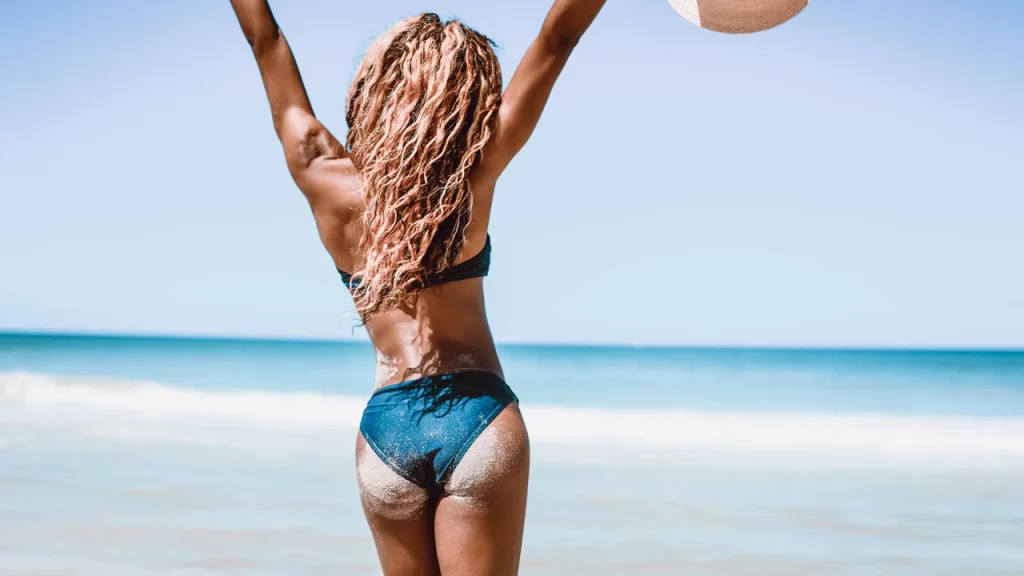Are you dealing with pimples on your butt? Read this! Butt acne, also known as “buttne,” bothers lots of people. It feels weird, awkward, and really annoying. But not to worry! If you know why it happens and how to treat it, you can get rid of those annoying bumps and feel more confident. This article explains what causes butt acne and shares the best ways to make it go away and stop it from coming back.
What is a butt acne?
Butt acne, also known as folliculitis, is a prevalent skin condition characterized by inflammation or infection of hair follicles in the buttocks. It can cause red bumps, pimples, or pustules on the buttocks.

Types of butt acne
1. Folliculitis:
Folliculitis is the most common type of butt acne. It occurs when hair follicles become inflamed or infected, leading to red, swollen bumps, sometimes with a white or yellow center. Friction from tight-fitting clothing, sweating, shaving, or waxing can contribute to folliculitis.
2. Pseudomonas Folliculitis:
Pseudomonas folliculitis, also referred to as hot tub folliculitis, is a specific type of folliculitis caused by bacteria from contaminated hot tubs, swimming pools, or shared towels. It manifests as itchy, red bumps that may develop into pustules.
3. Pityrosporum Folliculitis:
Pityrosporum folliculitis, also known as fungal folliculitis, is caused by excess proliferation of the yeast Malassezia, which naturally lives on the skin. It typically appears as small, itchy, red bumps that may cluster together.
4. Gram-Negative Folliculitis:
Gram-negative folliculitis is caused by bacteria that are resistant to antibiotics. It often develops in people with weakened immune systems or taking antibiotics frequently. The bumps associated with gram-negative folliculitis are typically larger and deeper than those of other types of folliculitis.
5. Demodex Folliculitis:
Demodex folliculitis is caused by an overgrowth of Demodex mites, which naturally live on human skin. These mites usually cause no problems, but an overgrowth can lead to inflammation and breakouts. Demodex folliculitis is more common in older adults and people with weakened immune systems.
6. Acne Vulgaris:
While less common than folliculitis, acne vulgaris can also occur on the buttocks. It manifests as the same blemishes seen on the face, such as blackheads, whiteheads, papules, and pustules.
What causes buttocks acne?
Buttock acne can be triggered by various factors:
- Folliculitis: This occurs when hair follicles get clogged, leading to inflammation and the formation of small, red bumps.
- Hormonal Changes: Fluctuations in hormone levels, especially during puberty, menstruation, pregnancy, or when using certain medications, can stimulate oil production, leading to acne.
- Bacterial Infections: Bacteria, like Staphylococcus aureus, can infect hair follicles or broken skin, causing acne-like lesions.
- Poor Hygiene: Not regularly washing the buttocks area can result in the accumulation of sweat, bacteria, and dead skin cells, contributing to acne formation.
- Genetics: Some individuals may be more predisposed to developing acne due to genetic factors.
- Dietary Factors: Although less directly linked, certain foods high in sugars or processed ingredients might exacerbate acne for some individuals.
How do you get rid of butt acne?
Here are some effective ways to get rid of butt acne:
- Maintain proper hygiene: Regularly wash the affected area with mild soap and water, especially after sweating or exercising. This helps remove dirt, sweat, and bacteria contributing to folliculitis.
- Wear loose-fitting clothing: Avoid tight-fitting clothes, especially when exercising or sweating, as they can trap heat and moisture, leading to irritation and inflammation. Choose breathable, loose-fitting clothing to allow better air circulation.
- Shower after sweating: After exercising or engaging in activities that cause sweating, shower promptly to remove sweat and bacteria from the skin. This helps prevent clogging of hair follicles and reduces the risk of infection.
- Use gentle shaving methods: If you shave your buttocks, use a gentle shaving cream or gel and a sharp razor to minimize irritation. Shave following the direction of hair growth and avoid shaving too frequently.
- Consider alternative hair removal methods: Waxing can irritate hair follicles, so consider alternative hair removal methods like trimming or using depilatory creams if shaving proves problematic.
- Apply over-the-counter ointments: Over-the-counter ointments or creams containing benzoyl peroxide or salicylic acid can aid in reducing inflammation and kill bacteria, promoting healing.
- Maintain a healthy weight: Being overweight or obese can increase the risk of folliculitis. Weight loss or maintaining a healthy weight can help reduce the likelihood of breakouts.
- Manage stress levels: Stress can worsen skin conditions, including folliculitis. Practice stress-management techniques like yoga, meditation, or deep breathing exercises to alleviate stress and improve overall skin health.
- Avoid picking or popping pimples: Picking or popping pimples can worsen inflammation, lead to scarring, and increase the risk of infection. Resist the temptation to touch or pick at pimples to allow them to heal naturally.
- Seek medical advice for persistent cases: If butt acne is severe, persistent, or unresponsive to home treatment, consult a dermatologist for evaluation and appropriate treatment options. They may prescribe stronger medications or suggest alternative treatments like laser therapy.
Conclusion
Butt acne is a common issue that can affect anyone, causing discomfort and embarrassment. However, the good news is that it’s a manageable condition with the right knowledge and approach. When you understand the root causes and adopt effective treatments, you can get rid of butt acne and regain your confidence.

